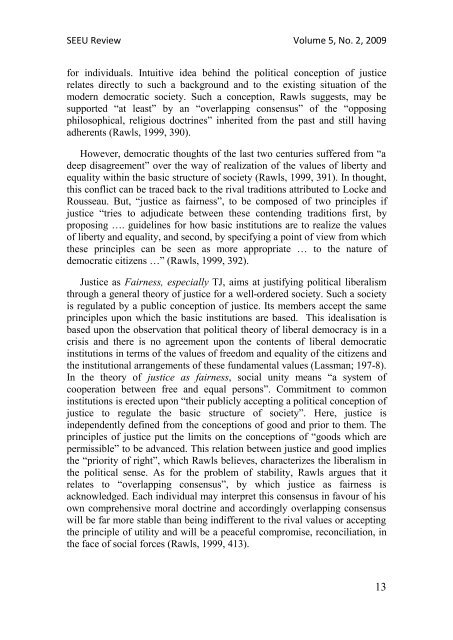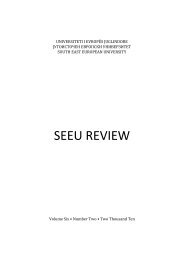SEEU Review vol. 5 Nr. 2 (pdf) - South East European University
SEEU Review vol. 5 Nr. 2 (pdf) - South East European University
SEEU Review vol. 5 Nr. 2 (pdf) - South East European University
Create successful ePaper yourself
Turn your PDF publications into a flip-book with our unique Google optimized e-Paper software.
<strong>SEEU</strong> <strong>Review</strong> Volume 5, No. 2, 2009<br />
for individuals. Intuitive idea behind the political conception of justice<br />
relates directly to such a background and to the existing situation of the<br />
modern democratic society. Such a conception, Rawls suggests, may be<br />
supported “at least” by an “overlapping consensus” of the “opposing<br />
philosophical, religious doctrines” inherited from the past and still having<br />
adherents (Rawls, 1999, 390).<br />
However, democratic thoughts of the last two centuries suffered from “a<br />
deep disagreement” over the way of realization of the values of liberty and<br />
equality within the basic structure of society (Rawls, 1999, 391). In thought,<br />
this conflict can be traced back to the rival traditions attributed to Locke and<br />
Rousseau. But, “justice as fairness”, to be composed of two principles if<br />
justice “tries to adjudicate between these contending traditions first, by<br />
proposing …. guidelines for how basic institutions are to realize the values<br />
of liberty and equality, and second, by specifying a point of view from which<br />
these principles can be seen as more appropriate … to the nature of<br />
democratic citizens …” (Rawls, 1999, 392).<br />
Justice as Fairness, especially TJ, aims at justifying political liberalism<br />
through a general theory of justice for a well-ordered society. Such a society<br />
is regulated by a public conception of justice. Its members accept the same<br />
principles upon which the basic institutions are based. This idealisation is<br />
based upon the observation that political theory of liberal democracy is in a<br />
crisis and there is no agreement upon the contents of liberal democratic<br />
institutions in terms of the values of freedom and equality of the citizens and<br />
the institutional arrangements of these fundamental values (Lassman; 197-8).<br />
In the theory of justice as fairness, social unity means “a system of<br />
cooperation between free and equal persons”. Commitment to common<br />
institutions is erected upon “their publicly accepting a political conception of<br />
justice to regulate the basic structure of society”. Here, justice is<br />
independently defined from the conceptions of good and prior to them. The<br />
principles of justice put the limits on the conceptions of “goods which are<br />
permissible” to be advanced. This relation between justice and good implies<br />
the “priority of right”, which Rawls believes, characterizes the liberalism in<br />
the political sense. As for the problem of stability, Rawls argues that it<br />
relates to “overlapping consensus”, by which justice as fairness is<br />
acknowledged. Each individual may interpret this consensus in favour of his<br />
own comprehensive moral doctrine and accordingly overlapping consensus<br />
will be far more stable than being indifferent to the rival values or accepting<br />
the principle of utility and will be a peaceful compromise, reconciliation, in<br />
the face of social forces (Rawls, 1999, 413).<br />
13

















